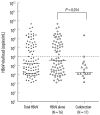Human bocavirus in patients with respiratory tract infection
- PMID: 21779192
- PMCID: PMC3129349
- DOI: 10.3343/kjlm.2011.31.3.179
Human bocavirus in patients with respiratory tract infection
Abstract
Background: Human bocavirus (HBoV) is a newly identified viral pathogen, and its clinical epidemiology and significance in respiratory infections have not yet been completely elucidated. We investigated the prevalence of HBoV infection and the association between viral (HBoV) load and clinical features of the infection in patients of all age-groups.
Methods: Nasopharyngeal aspirates from patients with symptoms of respiratory infection were tested for presence of HBoV by using real-time polymerase chain reaction. HBoV-positive patients were categorized into low- and high-viral-load groups using 1.0×10(6) copies/mL as the threshold value of viral load.
Results: Detection rate of HBoV was 4.8% (N=93) in a total of 1,926 samples with peak incidence of infection being observed in patients aged 6-12 months. HBoV infection was more frequently observed in young children, especially, in children aged less than 5 yr, and the HBoV load decreased with increase in age. HBoV was codetected with other respiratory viruses in 17 (18.3%) of the 93 HBoV-positive patients and 15 patients (88.2%) belonged to the low-viral-load group. Patients infected with HBoV alone showed a higher viral load than those patients in whom HBoV was codetected with other respiratory viruses (median load, 3.78×10(5) copies/mL vs. 1.94×10(4) copies/mL, P=0.014). Higher pulse rate (P=0.007) and respiratory rate (P=0.021) were observed in patients with a high-viral-load.
Conclusions: Our results suggest that HBoV may be the causative agent of respiratory infection in the high-viral-load group.
Keywords: Bocavirus; Respiratory tract infections; Viral load.
Conflict of interest statement
No potential conflict of interest relevant to this article was reported.
Figures



Similar articles
-
Human bocavirus infection in young children with acute respiratory tract infection in Lanzhou, China.J Med Virol. 2010 Feb;82(2):282-8. doi: 10.1002/jmv.21689. J Med Virol. 2010. PMID: 20029808 Free PMC article.
-
Human bocavirus infection in children with respiratory tract disease.Pediatr Infect Dis J. 2008 Nov;27(11):969-73. doi: 10.1097/INF.0b013e31817acfaa. Pediatr Infect Dis J. 2008. PMID: 18833027
-
Single detection of human bocavirus 1 with a high viral load in severe respiratory tract infections in previously healthy children.BMC Infect Dis. 2014 Jul 30;14:424. doi: 10.1186/1471-2334-14-424. BMC Infect Dis. 2014. PMID: 25078257 Free PMC article.
-
Human bocavirus.J Clin Virol. 2008 Jan;41(1):29-33. doi: 10.1016/j.jcv.2007.10.026. Epub 2007 Dec 11. J Clin Virol. 2008. PMID: 18055252 Review.
-
Human bocavirus: passenger or pathogen in acute respiratory tract infections?Clin Microbiol Rev. 2008 Apr;21(2):291-304, table of contents. doi: 10.1128/CMR.00030-07. Clin Microbiol Rev. 2008. PMID: 18400798 Free PMC article. Review.
Cited by
-
Human bocavirus isolated from children with acute respiratory tract infections in Korea, 2010-2011.J Med Virol. 2014 Dec;86(12):2011-8. doi: 10.1002/jmv.23880. Epub 2014 Jan 4. J Med Virol. 2014. PMID: 24390980 Free PMC article.
-
High human bocavirus viral load is associated with disease severity in children under five years of age.PLoS One. 2013 Apr 30;8(4):e62318. doi: 10.1371/journal.pone.0062318. Print 2013. PLoS One. 2013. PMID: 23638038 Free PMC article.
-
Clinical description of human bocavirus viremia in children with LRTI, Eastern Province, Saudi Arabia.Ann Thorac Med. 2015 Apr-Jun;10(2):146-9. doi: 10.4103/1817-1737.151437. Ann Thorac Med. 2015. PMID: 25829968 Free PMC article.
-
Human polyomavirus type six in respiratory samples from hospitalized children with respiratory tract infections in Beijing, China.Virol J. 2015 Oct 13;12:166. doi: 10.1186/s12985-015-0390-5. Virol J. 2015. PMID: 26463646 Free PMC article.
-
Surveillance and genome analysis of human bocavirus in patients with respiratory infection in Guangzhou, China.PLoS One. 2012;7(9):e44876. doi: 10.1371/journal.pone.0044876. Epub 2012 Sep 11. PLoS One. 2012. PMID: 22984581 Free PMC article.
References
MeSH terms
Substances
LinkOut - more resources
Full Text Sources
